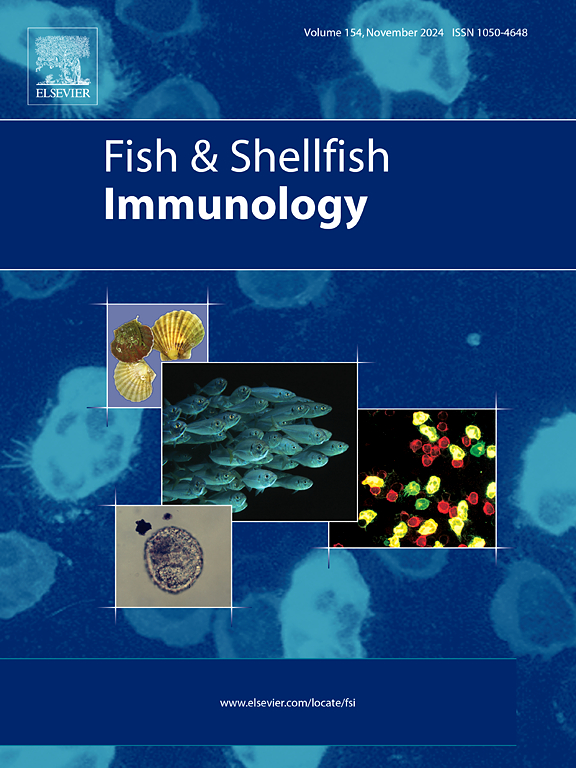Hemolysis-associated release of hemoglobin induces mitochondrial oxidative phosphorylation (OXPHOS) disturbance and aggravates cell oxidative damage in grass carp (Ctenopharyngodon idella)
IF 4.1
2区 农林科学
Q1 FISHERIES
引用次数: 0
Abstract
The liver is a key site for the removal of cell-free hemin during hemolysis. However, the mechanism underlying liver damage caused by hemolysis in teleost hemolytic disorderss remains unclear. In this study, the hemin incubation of grass carp liver cells (L8824) and phenylhydrazine (PHZ) injection were employed to simulate in vitro and in vivo hemolysis models. The Cell Counting Kit (CCK) assay results of the L8824 cells showed that the hemin caused obvious cell death and exhibited concentration-dependent characteristics. Furthermore, hemin stimulation significantly increased intracellular iron content, markedly enhanced intracellular ROS (reactive oxygen species) production, triggered the activation of genes linked to iron metabolism, and disrupted mitochondrial structural integrity. The quantitative real-time PCR (qRT-PCR) assay and enzyme activity findings indicated that the hemoglobin (Hb) treatment activated the activity and expression of mitochondrial respiratory chain complexes, while the addition of compound inhibitors I, II, and III could rescue hemin-induced cell death. Finally, a hemolysis model was established via intraperitoneal injection of PHZ in the grass carp. Histopathological analysis and in vivo transcriptome data showed that PHZ-induced hemolysis resulted in liver inflammation and iron and collagen fiber buildup. Additionally, immunofluorescence and immunohistochemical data indicated it enhanced the ROS generation, malondialdehyde (MDA), and 4-hydroxy-2-nonenal (4-HNE), destroyed the mitochondria, and up-regulated the transcription of mitochondrial respiratory chain complexes. In summary, the cell-free Hb released during hemolysis increased iron deposition, disrupted iron metabolism homeostasis, and caused oxidative stress. Consequently, this destroyed mitochondria function and ultimately exacerbated cell death.
溶血相关的 Hb 释放会诱发线粒体氧化磷酸化(OXPHOS)紊乱并加重草鱼细胞氧化损伤。
肝脏是溶血过程中清除细胞游离血红素的关键部位。然而,远东鱼类溶血性疾病溶血导致肝损伤的机制仍不清楚。本研究采用草鱼肝细胞(L8824)的血氨培养和苯肼(PHZ)注射模拟体外和体内溶血模型。对 L8824 细胞进行的细胞计数试剂盒(CCK)检测结果表明,hemin 会导致明显的细胞死亡,并表现出浓度依赖性特征。此外,hemin刺激可显著增加细胞内铁含量,明显增强细胞内ROS(活性氧)的产生,引发与铁代谢相关的基因活化,并破坏线粒体结构的完整性。实时定量 PCR(qRT-PCR)检测和酶活性研究结果表明,血红蛋白(Hb)处理激活了线粒体呼吸链复合物的活性和表达,而添加复合抑制剂 I、II 和 III 则可以挽救血红素诱导的细胞死亡。最后,通过腹腔注射 PHZ 建立了草鱼溶血模型。组织病理学分析和体内转录组数据显示,PHZ 诱导的溶血会导致肝脏发炎、铁和胶原纤维堆积。此外,免疫荧光和免疫组织化学数据表明,PHZ 增加了 ROS、丙二醛(MDA)和 4-羟基-2-壬烯醛(4-HNE)的生成,破坏了线粒体,并上调了线粒体呼吸链复合物的转录。总之,溶血过程中释放的细胞游离 Hb 增加了铁沉积,破坏了铁代谢平衡,并导致氧化应激。因此,这破坏了线粒体的功能,最终加剧了细胞死亡。
本文章由计算机程序翻译,如有差异,请以英文原文为准。
求助全文
约1分钟内获得全文
求助全文
来源期刊

Fish & shellfish immunology
农林科学-海洋与淡水生物学
CiteScore
7.50
自引率
19.10%
发文量
750
审稿时长
68 days
期刊介绍:
Fish and Shellfish Immunology rapidly publishes high-quality, peer-refereed contributions in the expanding fields of fish and shellfish immunology. It presents studies on the basic mechanisms of both the specific and non-specific defense systems, the cells, tissues, and humoral factors involved, their dependence on environmental and intrinsic factors, response to pathogens, response to vaccination, and applied studies on the development of specific vaccines for use in the aquaculture industry.
 求助内容:
求助内容: 应助结果提醒方式:
应助结果提醒方式:


